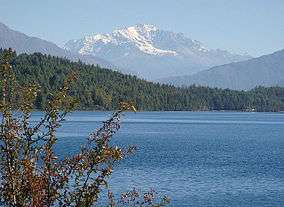Nanorana rarica
Nanorana rarica (common names: Rara paa frog, Rara Lake frog) is a frog species in the family Dicroglossidae. It is endemic to western Nepal.[2] Its type locality is the eponymous Rara Lake[3][2] located in the Rara National Park.[1]
| Nanorana rarica | |
|---|---|
| Scientific classification | |
| Kingdom: | Animalia |
| Phylum: | Chordata |
| Class: | Amphibia |
| Order: | Anura |
| Family: | Dicroglossidae |
| Genus: | Nanorana |
| Species: | N. rarica |
| Binomial name | |
| Nanorana rarica (Dubois, Matsui, and Ohler, 2001) | |
| Synonyms[2] | |
|
Rana (Paa) rara Dubois and Matsui, 1983[3] — preoccupied by Rana danubina var. rara Fraas, 1903 | |
Description
Adult males measure 37–46 mm (1.5–1.8 in), subadult males 27–30 mm (1.1–1.2 in), and subadult females 26–35 mm (1.0–1.4 in) in snout–vent length. The snout is rounded. The tympanum is not very distinct whereas the supratymapnic fold is prominent. Adult males have enlarged forelimbs. During the reproductive period, adult males have black, horny nuptial spines on their chest and forelimbs. The fingers are not webbed. The toes are long and webbed to their tips, although the webbing is strongly incurved between the toes. Preserved individuals are greyish above and have warts with blackish spots. There are numerous blackish markings on the head. The upper parts of the limbs have crossbars. The lower parts of the body and the limbs are whitish, while the throat is greyish.[3]
The tadpoles of Gosner stage 37 measure about 48–56 mm (1.9–2.2 in) in total length and 16–20 mm (0.6–0.8 in) in body length. They have a large oral disc and a muscular tail with not so well-developed caudal fin.[3]

Habitat and conservation
The habitat and ecological requirements of this species are poorly known. It is known from the Lake Rara at an elevation of about 3,000 m (9,800 ft) above sea level, and is associated with tropical montane forest. Threats to this species are not known. In addition to the Rara National Park, it might also occur in the Chitwan National Park.[1]
References
- Ohler, A.; Dutta, S. & Shrestha, T. K. (2004). "Nanorana rarica". IUCN Red List of Threatened Species. 2004: e.T58435A11780814. doi:10.2305/IUCN.UK.2004.RLTS.T58435A11780814.en. Retrieved 15 January 2018.
- Frost, Darrel R. (2018). "Nanorana rarica (Dubois, Matsui, and Ohler, 2001)". Amphibian Species of the World: an Online Reference. Version 6.0. American Museum of Natural History. Retrieved 16 October 2018.
- Dubois, Alain & Matsui, Masafumi (1983). "A new species of frog (genus Rana, subgenus Paa) from western Nepal (Amphibia: Anura)". Copeia. 1983 (4): 895–901. doi:10.2307/1445091. JSTOR 1445091.
